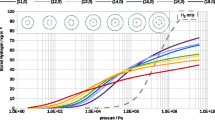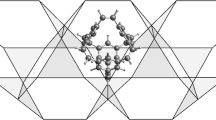Abstract
The potential energy curve for the adsorption of a hydrogen molecule by a truncated hollow sphere consisting of carbon atoms was evaluated by using the Lennard–Jones function for the pair interaction between a carbon atom and a hydrogen molecule. The sphere surface was regarded as a continuum with a uniform density identical to that of a graphite layer. The lower limit of the potential was found to be −200 meV when the sphere had a radius of 3.4 Å and no opening. By increasing the radius of the opening to 2.9 Å, the energy barrier for an incoming molecule disappeared and the lower limit increased to −150 meV, which is three times as deep as that observed for a graphite surface. The Langmuir isotherm for the truncated sphere of this size was evaluated based on the eigenvalues of the potential curve. We found that the pressure yielding a half occupancy was <50 bar at a temperature below 250 K. This indicates that a carbon pore with this shape and size can store a hydrogen molecule under mild conditions.




Similar content being viewed by others
References
Fuel Cell Technologies Office Multi-Year Research, Development, and Demonstration Plan, Section 3.3 Hydrogen Storage, 2012 http://energy.gov/sites/prod/files/2014/03/f12/storage.pdf. Accessed 12 Dec 2014
S.K. Bhatia, A.L. Myers, Langmuir 22, 1688 (2006)
L. Mattera, F. Rosatelli, C. Salvo, F. Tommasini, U. Valbusa, G. Vidali, Surf. Sci. 93, 515 (1980)
P. Bénard, R. Chahine, Langmuir 17, 1950 (2001)
U. Eberle, M. Felderhoff, F. Schüth, Angew. Chem. Int. Ed. 48, 6608 (2009)
S. Patchkovskii, J.S. Tse, S.N. Yurchenko, L. Zhchkov, T. Heine, G. Seifert, Proc. Natl. Acad. Sci. USA 102, 10439 (2005)
H. Cheng, A.C. Cooper, G.P. Pez, M.K. Kostov, P. Piotrowski, S.J. Stuart, J. Phys. Chem. B 109, 3780 (2005)
B. Kuchta, L. Firlej, P. Pfeifer, C. Wexler, Carbon 48, 223 (2010)
K.M. Thomas, Catal. Today 120, 389 (2007)
W.J. Fan, R.Q. Zhang, B.K. Teo, B. Aradi, Th. Frauenheim, Appl. Phys. Lett. 95, 013116 (2009)
G. Mpourmpakis, G.E. Froudakis, G.P. Lithoxoos, J. Samios, J. Chem. Phys. 126, 144704 (2007)
I. Cabria, M.J. Lopez, J.A. Alonso, Carbon 45, 2649 (2007)
J.A. Alonso, I. Cabria, M.J. Lopez, J. Mex. Chem. Soc. 56, 261 (2012)
Q. Wang, J.K. Johnson, J. Chem. Phys. 110, 577 (1999)
P. Kowalczyk, P.A. Gauden, A.P. Terzyk, S.K. Bhatia, Langmuir 23, 3666 (2007)
W.-Q. Deng, X. Xu, W.A. Goddard, Phys. Rev. Lett. 92, 166103-1 (2004)
M.T. Knippenberg, S.J. Stuart, A.C. Cooper, G.P. Pez, H. Cheng, J. Phys. Chem. B 110, 22957 (2006)
C.-I. Weng, S.-P. Ju, K.-C. Fang, F.-P. Chang, Comput. Mater. Sci. 40, 300 (2007)
S.S. Han, H.S. Kim, K.S. Han, J.Y. Lee, H.M. Lee, J.K. Kang, S.I. Woo, A.C.T. van Duin, W.A. Goddard, Appl. Phys. Lett. 87, 213113 (2005)
T. Yamabe, M. Fujii, S. Mori, H. Kinoshita, S. Yata, Synth. Met. 145, 31 (2004)
S. Ishikawa, T. Yamabe, Appl. Phys. A 114, 1339 (2014)
M. Hirscher, M. Becher, M. Haluska, U. Dettlaff-Weglikowska, A. Quintet, G.S. Duesberg, Y.-M. Choi, P. Downes, M. Hulman, S. Roth, I. Stepanek, P. Bernier, Appl. Phys. A 72, 129 (2001)
Y. Murata, M. Murata, K. Komatsu, J. Org. Chem. 66, 8187 (2001)
Y. Murata, M. Murata, K. Komatsu, J. Am. Chem. Soc. 125, 7152 (2003)
A.J. Stone, The Theory of Intermolecular Forces, 1st edn. (Clarendon Press, Oxford, 2002)
W.A. Steele, The Interaction of Gases with Solid Surfaces, 1st edn. (Pergamon Press, New York, 1974)
S. Ishikawa, T. Yamabe, Appl. Phys. A 99, 29 (2010)
R. Kubo, Statistical Mechanics, 2nd edn. (Elsevier, Amsterdam, 2004)
W.P. David, R.M. Ibberson, J.C. Matthwman, K. Prassides, T.J.S. Dennis, J.P. Hare, H.W. Kroto, R. Taylor, D.R.M. Wlaton, Nature 353, 147 (1991)
Conflict of interest
The authors declare that they have no conflict of interest.
Author information
Authors and Affiliations
Corresponding author
Appendix: List of symbols
Appendix: List of symbols
Symbols | Description |
|---|---|
\(\epsilon_{{{\text{C}}{\text{-}}{\text{H}}_{2} }}\) | Lennard–Jones potential depth between C and H2 |
\(\epsilon_{n}\) | The nth eigenvalue of the potential energy curve for the H2 adsorption |
θ | Azimuthal angle of the surface of the truncated carbon sphere |
θ a | Azimuthal angle of the opening edge on the truncated carbon sphere |
θ(p, T) | Occupancy of the H2 adsorption site given by the Langmuir isotherm |
ρ s | Surface density of the carbon sheet |
\(\sigma_{{{\text{C}}{\text{-}}{\text{H}}_{2} }}\) | Lennard–Jones distance parameter between C and H2 |
a | Opening radius of the truncated carbon sphere |
d | Radius of the truncated carbon sphere or the distance between H2 and an infinite single carbon sheet |
d e | Equilibrium radius of the closed carbon sphere for the H2 adsorption |
d g | Gravimetric H2 density of the substrate |
dσ | Surface element of the carbon surface |
d sg | Equilibrium distance between H2 and an infinite single carbon sheet |
d v | Volumetric H2 density of the substrate |
D | Potential depth of the H2 adsorption by the closed carbon sphere |
\(\overline{{N_{0} }} (T)\) | Lower limit of the number density of the H2 adsorption sites |
\(\overline{{N_{\text{site}} }}\) | Number density of the H2 adsorption sites |
\(\overline{{N_{{{\text{H}}_{2} }}^{\text{ads}} }} (p, T)\) | Number density of adsorbed H2 molecules in the substrate |
\(\overline{{N_{{{\text{H}}_{2} }}^{\text{gas}} }} \left( {p, T} \right)\) | Number density of gaseous H2 molecules |
p 0(T) | Half-occupancy pressure of the Langmuir isotherm for the H2 adsorption |
\(p_{ \hbox{max} } (T)\) | Pressure at which the substrate has the same H2 density as the gas |
r | Distance between C and H2 |
z | Position of the H2 molecule adsorbed by the truncated carbon sphere |
z ads(T) | Molecular partition function of the adsorbed H2 molecule |
z gas(T) | Molecular partition function of the gaseous H2 molecule per unit volume |
\(V_{\text{LJ}} \left( r \right)\) | Lennard–Jones potential |
W | Integral form of the H2 adsorption energy |
\(W_{\text{sg}} \left( d \right)\) | H2 adsorption energy by an infinite single carbon sheet |
W(z, d, a) | H2 adsorption energy by the truncated carbon sphere |
Rights and permissions
About this article
Cite this article
Ishikawa, S., Yamabe, T. The potential energy curve and Langmuir isotherm of hydrogen adsorption by a truncated carbon sphere. Appl. Phys. A 119, 1365–1372 (2015). https://doi.org/10.1007/s00339-015-9107-2
Received:
Accepted:
Published:
Issue Date:
DOI: https://doi.org/10.1007/s00339-015-9107-2




